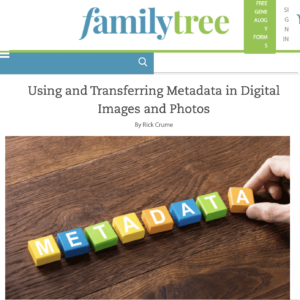Categories
Archives
Family Tree magazine has published a guide on using embedded metadata for photographs in genealogy – the study of family history.
Rick Crume, a genealogy consultant and the article’s author, says IPTC metadata “can be extremely useful for savvy archivists […] IPTC standards can help future-proof your metadata. That data becomes part of the digital photo, contained inside the file and preserved for future software programs.”
Crume quotes Ken Watson from All About Digital Photos saying “[IPTC] is an internationally recognized standard, so your IPTC/XMP data will be viewable by someone 50 or 100 years from now. The same cannot be said for programs that use some proprietary labelling schemes.”
Crume then adds: “To put it another way: If you use photo software that abides by the IPTC/XMP standard, your labels and descriptive tags (keywords) should be readable by other programs that also follow the standard. For a list of photo software that supports IPTC Photo Metadata, visit the IPTC’s website.“
“[IPTC] is an internationally recognized standard, so your IPTC/XMP data will be viewable by someone 50 or 100 years from now”
The article goes on to recommend particular software choices based on IPTC’s list of photo software that supports IPTC Photo Metadata. In particular, Crume recommends that users don’t switch from Picasa to Google Photos, because Google Photos does not support IPTC Photo Metadata in the same way. Instead, he recommends that users stick with Picasa for as long as possible, and then choose another photo management tool from the supported software list.
Similarly, Crume recommends that users should not move from Windows Photo Gallery to the Windows 10 Photos app, because the Photos app does not support IPTC embedded metadata.
Crume then goes on to investigate popular genealogy sites to examine their support for embedded metadata, something that we do not cover in our photo metadata support surveys.
The full article can be found on FamilyTree.com.